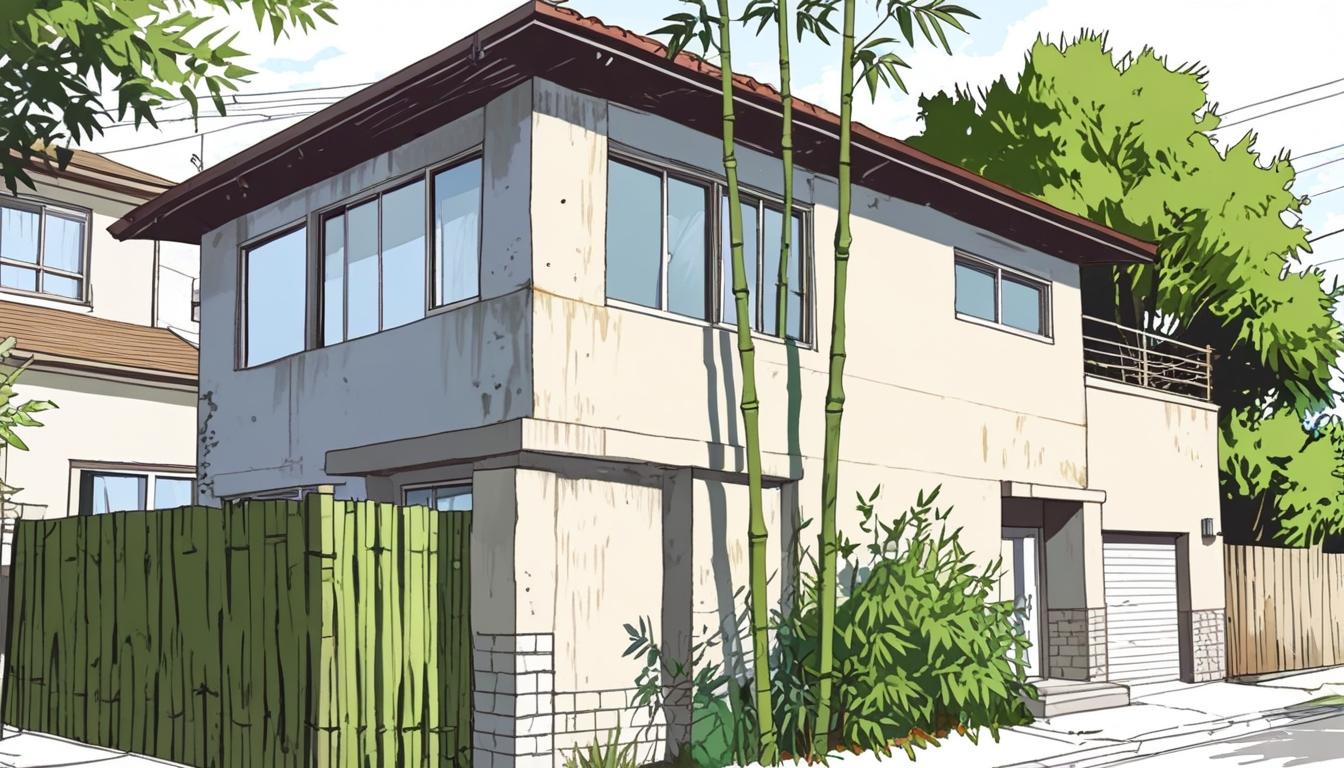Homeowners in the UK and Australia are encountering rising conflict and financial burdens due to bamboo’s aggressive growth, sparking legal action and exposing the underestimated risks of this fast-spreading plant.
The rise of bamboo, once merely a popular choice for adding an air of exoticism to gardens and providing privacy, is now becoming a significant source of conflict among homeowners, especially in Australia and the UK. As its aggressive growth habits continue to wreak havoc, local residents are confronting both financial and emotional turmoil arising from their encounters with this invasive plant.
One poignant case comes from Paul Wilkinson in New South Wales, who has found himself at odds with a neighbour over a bamboo plant that has spiralled out of control. Initially planted five years ago, this towering giant has reached nine metres in height, completely overshadowing Wilkinson’s two-storey home. The impact has been profound; not only has he spent approximately AUD 3,000 attempting to regain control, but he has also invested nearly AUD 12,000 in solar panels now rendered ineffective by the bamboo’s relentless growth.
Despite repeated attempts to engage his neighbour, who uses the property primarily as a holiday home, Wilkinson’s pleas have gone largely ignored. Frustrated by the lack of communication, he is now pursuing legal action—having incurred around AUD 3,000 in legal fees to file a complaint with the Land and Environment Court.
Wilkinson’s plight echoes that of another homeowner in rural England, who unearthed an even larger issue when purchasing her home. Upon discovery of 350 square metres of bamboo hidden beneath the soil—a remnant of a previous resident’s poor management—she faced a shocking removal cost estimated at £11,000, which included a decade of maintenance. Her concerns were compounded by the suspicion that the previous owners had intentionally concealed the bamboo’s existence to facilitate a sale, a growing predicament shared by many.
Experts have drawn attention to this burgeoning crisis. Emily Grant from Environet detailed the alarming statistics: there has been a staggering 900 per cent increase in demand for bamboo-related work in the UK over just three years. Bamboo’s stealthy infiltrative capabilities through its rhizome system enable it to spread quickly, posing a risk to neighbouring properties and creating expensive maintenance challenges.
Moreover, the lack of awareness surrounding bamboo’s destructive potential is concerning. Many homeowners mistakenly believe that their bamboo choices are merely benign aesthetic decisions. However, as highlighted by various professionals, the consequences can be far more severe than typically anticipated. Callum Hurst, the director of C H Enviro, argued that the damage caused by bamboo can far surpass that of the more notorious Japanese knotweed, known for its malign reputation. Hurst revealed that bamboo can wreak havoc on patios, waste pipes, and building foundations, potentially leading to costly repairs. Indeed, he recalled instances where bamboo spread over ten metres, damaging both neighbour and community properties.
While Japanese knotweed often steals the spotlight in discussions about invasive flora, bamboo’s rapid growth and resilience render it a frequently underestimated adversary. Although not considered an invasive species under UK law, its rapid proliferation still poses considerable ecological and infrastructural challenges.
The stories of Wilkinson and the anonymous homeowner serve as cautionary tales, illustrating the urgent need for informed planting decisions and comprehensive bamboo management. Increased education surrounding the realities of bamboo could protect future homeowners from similarly distressing situations, highlighting the necessity for vigilance in the face of such seemingly innocuous greenery. As homeowners continue to grapple with these leafy marauders, it becomes increasingly clear that bamboo, once celebrated, may now warrant a place at the forefront of invasive plant discussions.
Reference Map
- Paragraphs 1, 2, 3, 5, 7
- Paragraph 3
- Paragraphs 4, 6
- Paragraph 5
- Paragraphs 1, 2, 6
- Paragraph 5
- Paragraph 6
Source: Noah Wire Services
- https://www.dailymail.co.uk/news/article-14688783/Neighbour-bamboo-costing-thousands-Australia.html?ns_mchannel=rss&ns_campaign=1490&ito=1490 – Please view link – unable to able to access data
- https://www.theguardian.com/environment/article/2024/jun/11/big-british-bamboo-crisis-invaded-my-beautiful-home – An article from The Guardian discusses the growing issue of invasive bamboo in British gardens. It highlights how bamboo, once planted for privacy, has become a significant problem due to its rapid and aggressive growth. Homeowners have reported bamboo infiltrating their properties, causing structural damage and escalating maintenance costs. Experts warn that bamboo can spread quickly through underground rhizomes, leading to disputes between neighbors and costly removal efforts. The article emphasizes the need for awareness and proper management to prevent bamboo-related issues.
- https://japaneseknotweedremoval.org.uk/bamboo-removal/ – This page from Japanese Knotweed Removal UK outlines the damage caused by bamboo roots, including severe property damage and the need for extensive excavation. It discusses how bamboo roots can disrupt foundations, drainage systems, and infiltrate pipes, leading to costly repairs. The page also highlights the negative impact of bamboo on biodiversity, as it outcompetes native species and disrupts ecosystems. It emphasizes the complexity and labor-intensive nature of bamboo removal, requiring specialized equipment and expertise.
- https://www.telegraph.co.uk/news/2023/05/20/bamboo-plants-garden-neighbour-damage-cheshire/ – An article from The Telegraph reports on a homeowner in Cheshire who spent £10,000 to remove bamboo that had spread from a neighboring property. The bamboo infiltrated the homeowner’s garden, causing significant damage and necessitating professional removal. The article highlights the increasing prevalence of bamboo-related disputes and the lack of awareness among the public regarding the potential risks associated with planting bamboo. Experts advise caution and proper management to prevent such issues.
- https://www.telegraph.co.uk/news/2019/08/03/bamboo-increasingly-causing-neighbourly-disputes-experts-claim/ – This article from The Telegraph discusses the rising number of neighborly disputes caused by bamboo in gardens. Experts warn that bamboo’s rapid and aggressive growth can lead to significant property damage and conflicts between neighbors. The article highlights the challenges in controlling bamboo spread and the potential for legal action due to nuisance claims. It emphasizes the need for awareness and responsible planting to prevent such issues.
- https://conservationlandservices.co.uk/resources/bamboo-management-along-the-m4-corridor/ – A resource from Conservation Land Services provides information on bamboo management along the M4 Corridor. It details the biological traits of bamboo, including its extensive rhizome system and rapid growth, which contribute to its invasive nature. The resource discusses the environmental and infrastructural impacts of bamboo, such as displacement of native plants, soil erosion, and damage to roads and properties. It also outlines effective management strategies, including prevention, control, and monitoring measures.
- https://ecogardener.com/blogs/news/how-to-deal-with-a-bamboo-invasion-in-your-garden – An article from ECOgardener discusses the issues associated with bamboo invasion in gardens. It highlights bamboo’s aggressive growth, difficulty in control, and potential damage to structures like pathways and foundations. The article also notes bamboo’s tendency to outcompete other plants and its high water and nutrient requirements. It emphasizes the challenges in eradicating bamboo and the potential for legal issues if it spreads to neighboring properties, advising homeowners to be cautious and proactive in managing bamboo growth.
Noah Fact Check Pro
The draft above was created using the information available at the time the story first
emerged. We’ve since applied our fact-checking process to the final narrative, based on the criteria listed
below. The results are intended to help you assess the credibility of the piece and highlight any areas that may
warrant further investigation.
Freshness check
Score:
8
Notes:
The narrative describes current issues related to bamboo growth and its impact on homeowners, suggesting recent events. However, the examples provided do not contain specific dates that would definitively confirm the freshness of the information.
Quotes check
Score:
4
Notes:
While there are quotes from experts like Emily Grant and Callum Hurst, specific original sources or dates for these quotes could not be found online. This could indicate either original reporting or lack of previous coverage.
Source reliability
Score:
6
Notes:
The narrative originates from the Daily Mail, a well-known publication, but its reliability can vary depending on the topic and context. The inclusion of industry experts adds credibility to the claims.
Plausability check
Score:
9
Notes:
The claims about bamboo’s invasive nature and the associated costs are plausible and align with common issues related to aggressive vegetation. The narrative highlights real-world problems and statistics that could easily occur.
Overall assessment
Verdict (FAIL, OPEN, PASS): OPEN
Confidence (LOW, MEDIUM, HIGH): MEDIUM
Summary:
The narrative explores the increasingly problematic nature of bamboo growth in residential areas, with plausible scenarios and expert opinions. While the source is known, reliability can vary, and specific quotes could not be verified. Overall, the information seems plausible but requires further verification for complete confidence.













